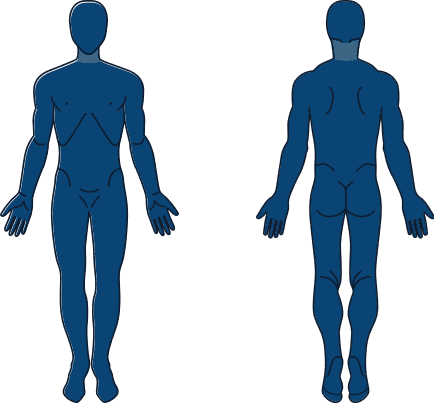What is a groin strain?
- The groin is a general term describing structures located in and around the inner thigh.
- These include the adductor muscles, the iliopsoas muscle, the medial hip joint, the pubic bones, the lower abdominal, as well as pain referred to that area from other sites.
- A groin strain refers to an injury or abnormality in any of these structures causing medial thigh pain.
What are some of the typical causes of a groin strain?
- An injury to any of the structures in the medial hip/thigh region or structures that can refer pain to that area can all be considered a type of groin injury, however classically groin strains result from sudden or repetitive lateral movements.
What are the symptoms of a groin strain?
- Medial hip/thigh pain worsened with activity.
What are some initial treatments?
- Rest, Ice, Taping/strapping, Anti-Inflammatories.
What is a hamstring injury?
- A hamstring injury is a strain or tear of the muscled in the back of the thigh. These muscles work to bend the knee and decelerate the lower leg when walking/running.
What are some of the typical causes of a hamstring injury?
- The hamstring are typically injured during high intensity activities like running, cycling, or any activity that involves forceful contraction of the muscles.
- Hamstrings can also be injured when stretching
What are the symptoms of a hamstring injury?
- Pain, swelling, and bruising in the back of the thigh, pain when bending over or squatting
What are some initial treatments?
- Rest, Ice, Compression, anti-inflammatories, gentle stretching after a few days.
What is hip osteoarthritis?
- Osteoarthritis is the degenerative breakdown of the smooth, firm tissue that lines the ends of the bones in the joints.
- This can happen in any joint but is common in the hip.
What are some of the typical causes of hip arthritis?
- The exact cause of osteoarthritis is unknown; however it is believed to be a combination of genetic, immune, biomechanical, and inflammatory factors.
- There are several factors that increase the risk of developing hip osteoarthritis including increased weight, increased participation in activitiesthat stress the hips, previous hip injuries, and having "loose joints".
What are the symptoms of hip arthritis?
- Hip pain, stiffness (especially when rising), crepitation (grinding/cracking hips)
What are some initial treatments?
- Heat, ice, anti-inflammatories, weight loss, stretching.
What is a hip flexor strain?
- The hip flexor is a general term used to describe the group of muscles located in the anterior hip/thigh region that assist and enable the flexion (bending) of the hip.
- An overstretching or tearing of any of these muscles can be considered a hip flexor strain.
What are some of the typical causes of a hip flexor strain?
- Typical causes of hip flexor strains include any activities that involve forceful flexion (bending) of the hip (running, jumping, cycling, etc)
What are the symptoms of a hip flexor strain?
- Pain in the anterior hip that’s worsened with lifting the leg or stretching the hip.
What are some initial treatments?
- Rest, Ice, Therapeutic exercises.
What is snapping hip syndrome?
- Snapping hip syndrome is the sensation of snapping felt in the hip with activity.
- The two structures most commonly involved are the iliotibial band snapping over the greater trochanter of the lateral hip and the iliopsoas muscle snapping over a bump (iliopectineal eminence) on the hip.
What are some of the typical causes of a snapping hip?
- Sometimes there is no specific injury that causes snapping hip. It may be caused by overuse and inflammation of any of the bursa located in and around the hip, or from a strain of any of the muscles acting on the hip.
What are the symptoms of a snapping hip?
- Snapping sensation in the outer hip or anterior hip depending on the structures involved.
What are some initial treatments?
- Rest, Ice, Physical therapy
What is trochanteric bursitis?
- A bursa is a fluid filled sac that acts as a cushion between bones, tendons, and skin. Bursa aide in reducing the friction between these structures when moving.
- The trochanteric bursa is located on the lateral (outside) of the hip.
- Bursitis is an inflammation of this bursa due to increased friction or irritation.
What are some of the typical causes of trochanteric bursitis?
- Excessive friction on the bursae caused by strains and weakness of the gluteal muscles that attach to the greater trochanter.
What are the symptoms of trochanteric bursitis?
- Lateral (outside) hip pain with activity, pain when laying on the affected side.
What are some initial treatments?
- Rest, Ice, Anti-inflammatories.
